Anna Bilińska | |
|---|---|
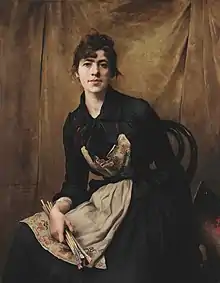 Self-Portrait with Apron and Brushes, 1887 | |
| Born | 8 December 1854 |
| Died | 8 April 1893 (aged 38) |
| Nationality | Polish |
| Known for | Painting |
| Notable work | A Negress (1884) At the Seashore (1886) |
| Movement | Realism |
| Spouse | Antoni Bohdanowicz |
Anna Bilińska (pronounced: [ˈanna biˈliɲska] also known as Anna Bilińska-Bohdanowicz; 8 December 1854 – 8 April 1893) was a Polish painter, known for her portraits. A representative of realism, she spent most of her life in Paris, and is considered the "first internationally known Polish woman artist."[1]
Life
Early years
She was born 1854 in Zlatopol (formerly a frontier town of the Russian Empire, today a part of Novomyrhorod, Ukraine) as Anna Bilińska, and spent her childhood there with her father, a Polish physician. Of her background, she joked that she "ha[d] a Cossack's temperament, but a Polish heart" (Polish: ma temperament kozaczy, ale serce polskie).[2] The family then moved to Central Russia, where Anna’s first art teachers were Ignacy Jasiński and Michał Elwiro Andriolli, both deported by the Tsarist government to Vyatka for their part in the January Uprising of 1863–1864.
In 1875, Bilińska's mother moved the family to Warsaw, enrolling her of-age children in the conservatoire. Anna was a talented pianist, an activity considered a suitable achievement for a woman of her class and time. But painting, a more suspect pursuit, would become her preference.[1]
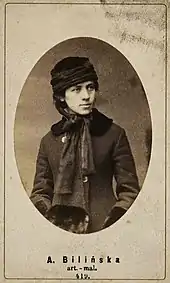
In 1877, she became a student of the painter Wojciech Gerson and began to exhibit her work at Warsaw's Zachęta Society for the Promotion of Fine Arts (Polish: Towarzystwo Zachęty Sztuk Pięknych).[3] Against her parents' wishes, she hired her own studio at 2 Nowy Świat Street, selling her paintings and paying the studio's rent from her own funds.[1]
Europe: travels to Austria, Italy & Paris
In early 1882, she accompanied her chronically ill friend Klementyna Krassowska on a journey to Munich, Salzburg, Vienna and northern Italy, before traveling to and settling in Paris, where she studied along with Marie Bashkirtseff and English artist Emmeline Deane at the Académie Julian,[4] and where later she also taught. In 1884, her father, Jan Biliński, and Krassowska died, leaving her emotionally devastated. However, her future was financially secured in Krassowska's last will and she was taken care of by fellow painter Maria Gażycz who lived in Normandy.[5]
In 1889, she presented her Self-Portrait at the Exposition Universelle in Paris for which she was awarded a silver medal and was granted the right to exhibit her works out of competition during future editions of the event.[6] This proved to be her first major international success. In 1889, her works were exhibited at the Royal Academy of Art in London.[7] In 1891, they were displayed at an annual international exhibition in Berlin where she was awarded a gold medal.[8]
She lived in France until 1892, when she married Antoni Bohdanowicz, a doctor of medicine, and took his name. After their marriage, they returned to Warsaw, where she intended to open a Parisian-style art school for women, but fell ill with a heart condition and died a year later on 8 April 1893. She was interred at Warsaw's Powązki Cemetery.[9]
Works
Anna Bilińska is best known for her portraits, especially those featuring women, painted with great intuition. Her Self-Portrait with Apron and Brushes (1887) developed a new self-portrait pose by placing the artist in front of a model's backdrop, thus stating that she is her own model.[11] Her portrait titled By the Window (1890), painted using the pastel technique, was regarded by 19th-century critics as Bilińska's most modern painting considering its subject matter, framing, and the use of light. It depicts a young girl leaning out of a window towards a sunlit garden and was probably painted during the artist's summer holiday spent in the fishing village of Boyardville.[6] Among her notable male portraits is the portrait of American sculptor George Grey Barnard painted in 1890 at the request of Alfred Corning Clark.[6] She also painted still lifes, genre scenes and landscapes using oil watercolors and sometimes pastels.
Two of Bilińska's paintings went missing after World War II: A Negress (1884) and The Italian Woman (1880). The former was rediscovered at an auction in Germany in 2011 and successfully reclaimed in 2012 thanks to the efforts of the Ministry of Culture and National Heritage of Poland. It is currently displayed at the National Museum in Warsaw.[12]
Her paintings can be found in the National Museum in Warsaw, National Museum in Wrocław, National Museum in Kraków, Victoria Art Gallery in Bath, Musée d'art moderne in Saint-Étienne, Lviv National Art Gallery, Gothenburg Museum of Art, State Museum of Pennsylvania, Berlin Musical Instrument Museum as well as private collections.[13]
Legacy
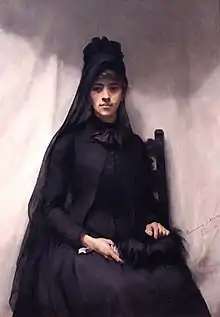
Bilińska is considered the first female Polish artist to receive a professional artistic education at an academic level and to earn critical acclaim abroad.[1][14] She was included in the 2018 American Federation of Arts' exhibition Women Artists in Paris, 1850–1900.[15]
Shortly after Bilińska's father died in 1882, Bilińska's portrait, depicting the artist in deep mourning, was painted by her friend, Emmeline Deane, in Paris. This painting (now in the Victoria Art Gallery) evoked such emotional intensity of loss that, when exhibited in Paris and London, it "caused such a stir that it featured in a cartoon in Punch magazine."[16] The work is considered to be significant because it was not common, at that time, for women painters to create formal salon-style portraits of other women painters, let alone to exhibit them.[17]
Bilińska's work was not well known through the 20th century, even in her home country. Some credit the "prejudices of the time and her own early death and short career" for this lack of recognition,[16] but, if so, it was a fate she held in common with numerous other gifted women painters of the 19th century. In 2017, thirty-seven of these "forgotten female artists" were featured in the traveling exhibition, Women Artists in Paris, 1850–1900. The show codified the works of numerous 19th century women artists whose paintings had begun to be increasingly appreciated. The show was criticized for failing to fully explore why these artists "continue to be underestimated."[18]
In 2021 the National Museum in Warsaw held a major retrospective of Bilińska work, displaying over 120 paintings (including Deane's 1886 portrait).[14] The exhibition's biographical notes provided a timely assessment of her work, proclaiming that Bilińska's paintings had become "part of the canon of Polish art," while simultaneously reflecting that the scholarship on her "entire œuvre and life story" remained, as yet, incomplete.[19] The exhibition reviewers' consensus appeared to be that the show was finally bringing Bilińska the "recognition she deserves,"[16] and at the same time advancing further questions about her art and life.
Exhibitions
Posthumous
- Artystka, Anna Bilińska 1854–1893; (26 Jun – 10 Oct 2021)[19] National Museum in Warsaw, Poland. Solo retrospective.
- Women Artists in Paris, 1850–1900; (22 Oct 2017 – 15 Jan 2018) Denver Art Museum, Colorado (17 Feb – 13 May 2018); Speed Art Museum in Louisville, Kentucky; and (9 Jun – 3 Sep 2018) at the Clark Art Institute, Williamstown, MA.[20]
Gallery
Selected paintings
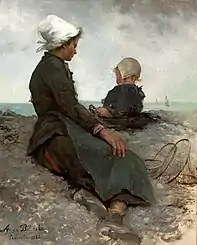
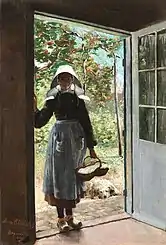 Breton Woman Standing on a Doorstep, 1889, National Museum in Wrocław
Breton Woman Standing on a Doorstep, 1889, National Museum in Wrocław Self-Portrait, unfinished (1892), National Museum in Warsaw
Self-Portrait, unfinished (1892), National Museum in Warsaw Portrait of Sculptor George Grey Barnard in His Atelier (1890), State Museum of Pennsylvania
Portrait of Sculptor George Grey Barnard in His Atelier (1890), State Museum of Pennsylvania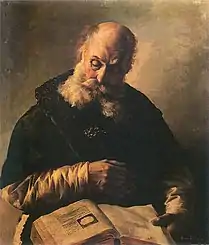 Old Man with a Book (1890s), Lviv National Art Gallery
Old Man with a Book (1890s), Lviv National Art Gallery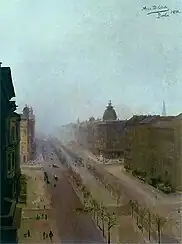 Under the Linden Trees, Berlin (1890), National Museum in Warsaw
Under the Linden Trees, Berlin (1890), National Museum in Warsaw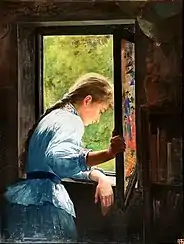 By the Window (1890), Musée d'art moderne in Saint-Étienne
By the Window (1890), Musée d'art moderne in Saint-Étienne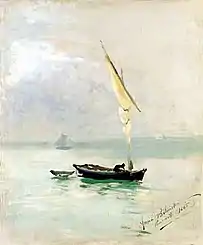 Sailing Boats in Pourville (1885), Private collection
Sailing Boats in Pourville (1885), Private collection
See also
Bibliography
- Clara Erskine Clement, Women in the Fine Arts from the Seventh Century B.C. to The Twentieth Century A.D., 1904
- Magdalena Schlender, Die Selbstbildnisse der polnischen Malerin Anna Bilińska (The self-portraits of the Polish painter Anna Bilińska), Hamburg 2005
- Magdalena Schlender, Anna Bilińska Bohdanowicz, probably 2009.
References
- 1 2 3 4 Tyszkiewicz, Olga (22 October 2020). "Striving For Freedom: The Artistic Career of Anna Bilińska-Bohdanowicz". culture.pl. Adam Mickiewicz Institute. Retrieved 28 May 2022.
- ↑ Renata Higersberger. Piękna, Skradziona, Odzyskana. nimoz.pl
- ↑ ""Artystka. Anna Bilińska 1854-1893". Nowa wystawa w Muzeum Narodowym w Warszawie" (in Polish). 28 June 2021. Retrieved 20 July 2021.
- ↑ "Anna Bilińska-Bohdanowicz". Culture.pl.
- ↑ "Anna Bilińska: the groundbreaking 19th-century artist who defied adversity to inspire others". 29 June 2021. Retrieved 20 July 2021.
- 1 2 3 "Anna Bilińska: Niezwykła portrecistka" (in Polish). Retrieved 20 July 2021.
- ↑ "Anna Bilińska-Bohdanowicz" (in Polish). Retrieved 20 July 2021.
- ↑ ""Artystka". Anna Bilińska 1854 –1893, w Muzeum Narodowym" (in Polish). 25 June 2021. Retrieved 20 July 2021.
- ↑ "Warszawskie Zabytkowe Pomniki Nagrobne". Archived from the original on 22 July 2021. Retrieved 20 July 2021.
- ↑ "Another WW II looted painting returned to Poland". The Central Registry of Information on Looted Cultural Property, 1933-1945, Commission for Looted Art in Europe. 20 March 2012. Retrieved 29 May 2022.
- ↑ Frances Borzello, Seeing Ourselves: Women's Self-Portraiture, 1998.
- ↑ "Murzynka". Retrieved 20 July 2021.
- ↑ ""Artystka. Anna Bilińska 1854–1893" w Muzeum Narodowym w Warszawie" (in Polish). Retrieved 20 July 2021.
- 1 2 Konopka, Blanka (2 July 2021). "Painting pioneer who 'dazzled Paris' goes on display to place her as one of Poland's greats". thefirstnews.com. Polish Press Agency . Retrieved 28 May 2022.
- ↑ Madeline, Laurence (2017). Women artists in Paris, 1850–1900. New Haven & New York: Yale University Press & American Federation of Arts. ISBN 978-0300223934.
- 1 2 3 Wall, Katharine (28 January 2021). "The Great British Art Tour: time at last to pay Anna Bilinska proper attention". The Guardian. UK. Retrieved 28 May 2022.
- ↑ Top 10 Treasures of Victoria Art Gallery: EMMELINE DEANE: ANNA BILINSKA / Series, retrieved 29 May 2022
- ↑ Bissonnette, Meghan (2018). "Her Paris: Women Artists in the Age of Impressionism". Art Inquiries. 17 (3): 336 – via Gale.
- 1 2 "Artystka, Anna Bilińska 1854–1893". National Museum in Warsaw. 2021. Retrieved 29 May 2022.
- ↑ "Women Artists in Paris, 1850–1900". The Clark Art Institute. June 2018. Retrieved 29 May 2022.
External links
- Anna Bilińska-Bohdanowicz at culture.pl
- Top 10 Treasures of Victoria Art Gallery: EMMELINE DEANE: ANNA BILINSKA / Series
- Short, exhibition related video: Artystka, Anna Bilińska 1854–1893 (with Polish titles)
 Media related to Anna Bilińska-Bohdanowiczowa at Wikimedia Commons
Media related to Anna Bilińska-Bohdanowiczowa at Wikimedia Commons
